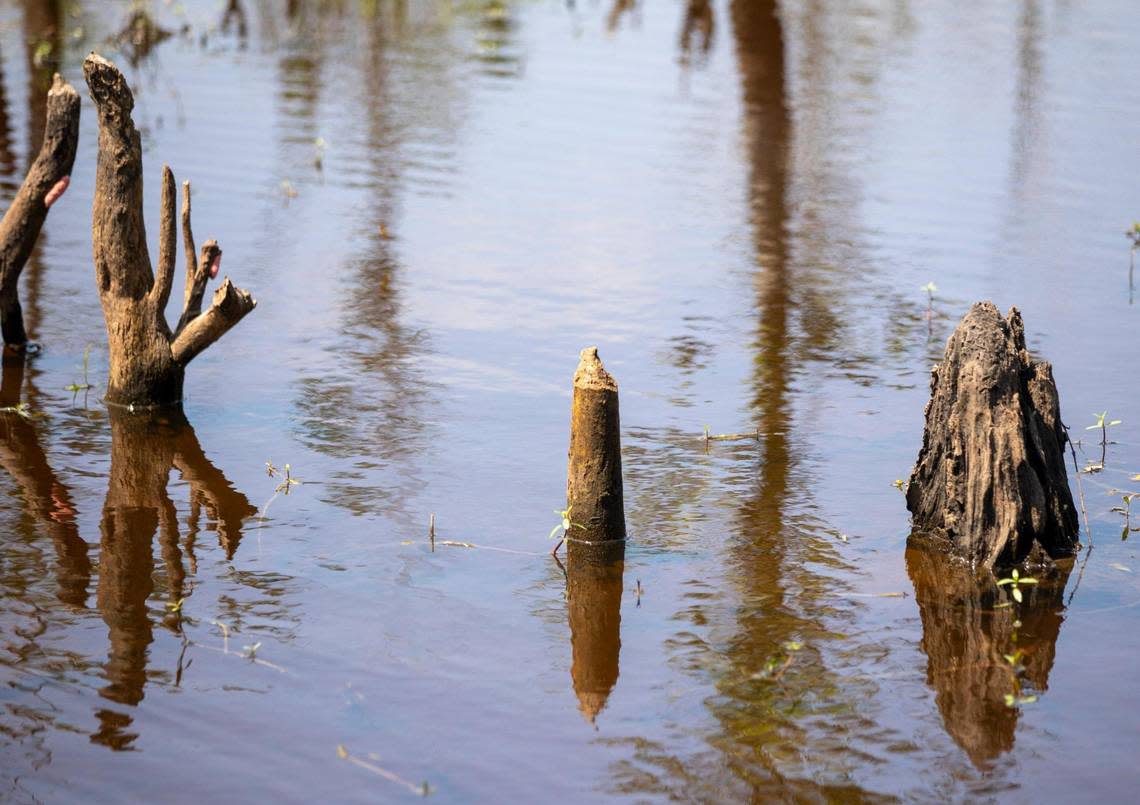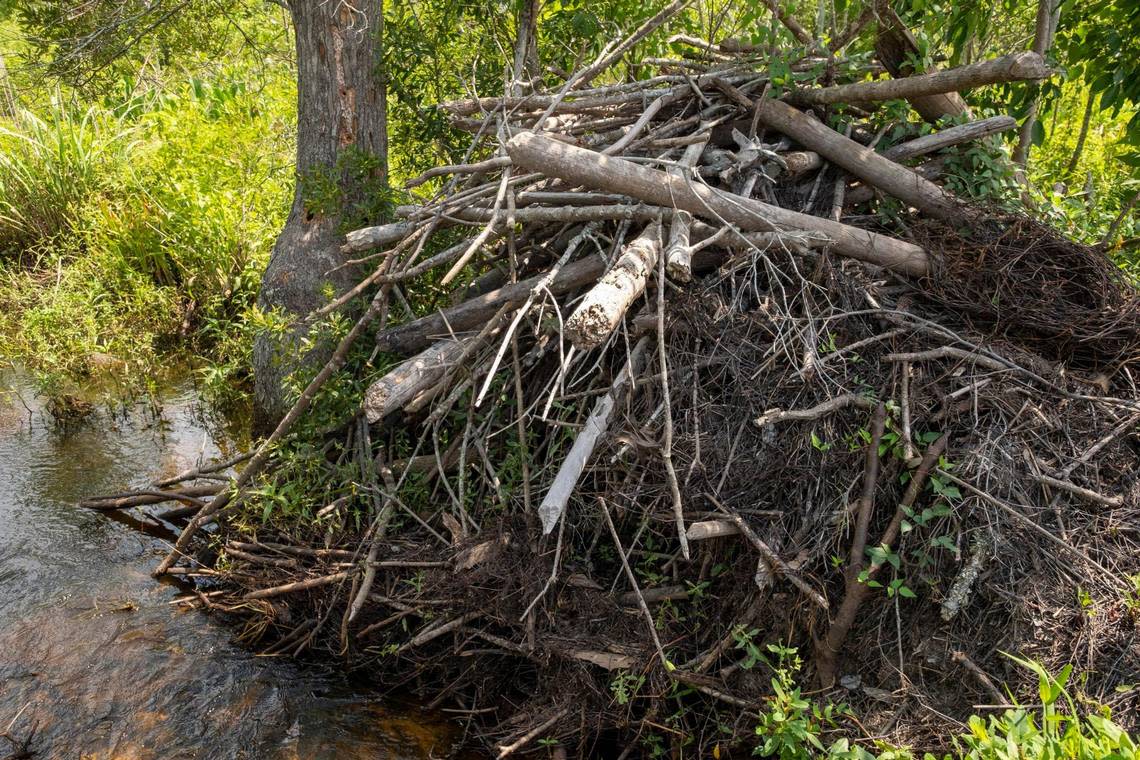In Horry County, beavers cause major flooding. Rapid growth is making it worse
For years, beaver dams built across Steritt Swamp made Ken Richardson’s property along the Waccamaw River flood from time to time.
The stormwater draining from the S.C. 90 corridor and part of Carolina Forest would flow through the swamp and into the river, but get backed up by the beaver dams. His driveway was occasionally under water.
But it was manageable, he said, because he had a system: He’d buy $1,500 of dynamite for the U.S. Department of Agriculture’s beaver trappers to destroy the large dams and alleviate the flooding. The trappers could kill anywhere between six to 18 beavers a year he said.
As the years went on, though, the flooding got worse and worse. In recent years, his property flooded twice, even three times, a year.
And Richardson knew the culprit. Not beavers, but new development.
“Beaver dams or no beaver dams, you can’t go building and filling everything up,” Richardson said. “The water has to go somewhere.”
“You’re going to have some flooding and nothing is going to prevent that,” he added. “But when you get a normal three or four-inch rain storm and its causing flooding, that’s a problem.”

The 114 acres of land owned by the outgoing Chairman of the Horry County Board of Education serves as a unique case study: Over the course of two decades, Richardson was able to see how new building near his home caused more and more flooding, even as he waged a continual battle against the beavers that contributed to it. He sold the property a year ago.
And Richardson’s land highlights one of Horry County’s most complex problems: Flooding.
Horry County is naturally flat and swampy, and residents have battled nature for decades and centuries as they’ve built homes, tilled farms and paved roads. In some parts of the county, beaver dams flood fields, roads and even some homes, making them a perennially urgent problem for Horry County. Nowadays, though, residents and stormwater crews have to contend with another factor: New development.
And that’s created additional pressure on county government as Stormwater Department crews contend with beavers, which are still causing flooding even as they lose habitat from new building.
“(Beavers) can cause some localized flooding,” Trapper Fowler, the north coast project manager for the Coastal Conservation League, said. “Going out and removing beavers is not going to solve our landscape-scale flooding issues by any means. There’s a lot of things we need to consider first and concentrate on first like where we develop and how we impact wetlands.”
On the frontlines of Horry County’s beaver problem
It’s a hot, muggy June day when Thom Roth, the head of the Horry County Stormwater Department, and his deputies trek out past Scipio Lane in the Burgess area to one of the county’s larger beaver dams.
The dam has been here for years, and some small trees have even taken root on top of it. Roth estimates the dam runs up to 400 feet across Mill Creek.
This particular beaver dam is on Roth’s radar because, in 2014, it contributed to serious flooding. Southern Horry County had gotten heavy back-to-back rains, and that, plus the dam, stranded the residents of Surfside Plantation in their homes for two weeks, Roth said.
“Water didn’t get in any homes but people couldn’t get out for two weeks because the water two to three feet deep,” he said.
That’s a dangerous situation, he said, because driving on flooded roads can destroy cars or otherwise make drivers unsafe.

Such situations were common after 2018’s Hurricane Florence, and have been a motivating factor for county leaders to begin studying infrastructure improvements along S.C. 90.
Other rains have threatened nearby public buildings, including an Horry County office building and the South Strand Recreation Center, with flooding. Those buildings haven’t yet flooded, Roth said, but the water has made Scipio Lane impassable.
“This (dam) has been an ongoing issue for quite a while,” Roth said.
So, Roth and his crews have set out to destroy the massive beaver dam in hopes of preserving the county’s buildings and nearby roads.
But doing so is not an easy task, partly because of landowners, partly because beavers are smart.
To destroy a beaver dam, Roth said, the Stormwater Department must figure out who owns the land where the beaver dam is located, mail them a letter asking for permission to enter their land and destroy the beaver dam, and received back signed documents. If the Stormwater crews suspect beavers might still live near the dam, the U.S. Department of Agriculture has to repeat the process.

All of that can take weeks, if not months.
If the USDA receives permission from the landowner, they tend to go first, Roth said, to trap the beavers. Common beaver traps are like large mouse traps, with a bar that swings down to break the beaver’s neck once triggered, according to Ricky Williams, the president of the South Carolina Trappers Association.
But, Williams and Roth both said, beavers are smart, and can learn how to avoid traps. It may take USDA agents several months to clear all of the beavers out of a particular area. Horry County budgets $270,000 annually to contract with the USDA’s four local beaver trappers. County spokesperson Kelly Moore said the county couldn’t estimate how much it spends in total on combating beavers.
Once the beavers are gone, either the USDA or county Stormwater crews can return to destroy the dam. The USDA occasionally uses dynamite to blow up the dams. Stormwater crews are equipped with a track hoe, excavators and other tools to knock out sections of the dam. Roth said crews had punched a 10 foot holes in the dam, and that his crews planned to come back soon with the track hoe to destroy up to 200 feet of the dam.
County data shows that the Stormwater Department is actively monitoring more than 60 beaver dams across the county.
“County wide this is a major problem,” Roth said. “Unfortunately, as flat as we are, the only way that water can get from point A to point B is through a run. It doesn’t take much to hold water back...a beaver comes in and clogs it up.”
The dual threat of beavers and development
On Chris Stevens’ farm, beavers cause some of his biggest problems.
Namely, a beaver dam floods 10 acres of his field meaning he hasn’t been able to plant there for several years. That’s about half of his total field, which he farms partly as hobby, partly for extra income. He sells farm insurance as his day job.
“We’ve been dealing with beavers for years on our farm,” he said. “It’s been an ongoing task for 30 years or more and it really doesn’t seem like we’ve made any headway, they’re really hard to trap.”
But Stevens is also keenly aware of development creeping into Horry County’s rural areas, potentially making the natural problems worse.
That’s because beavers often dam up canals or streams in or near wetlands. And wetlands, in a flat place like Horry County, are viewed as essential to control flooding. Farmers, Stevens said, learned this a long time ago and purposefully avoid tilling the parts of their property that hold water.

“From someone who farms, you look at these odd shaped fields and sometimes you see a patch of trees and you wonder, ‘Why can’t I clear that out and make the farm bigger?’” Stevens said. “Our ancestors didn’t do that because it’s wetlands.”
“Our county is full of bays and other non jurisdictional wetlands that may not hold water all the time but they hold water during flood events,” he added. “It seems like it’s easily over looked, we turn a blind eye every time we see a developer request to build on these properties.”
So how can Horry County combat its flooding problems?
It will have to pursue a dual effort of combating the problematic beavers while also working to prevent the sprawl of new building, environmentalists said. This year’s midterm elections will have big consequences for how the county approaches development, once the winners take office in six months.
But one major boost? Horry County doubled its stormwater fee in 2021, meaning Roth’s department can hire dozens of additional staff members and buy bigger equipment to clear out drainage ditches and destroy problematic beaver dams.
Williams, of the Trappers Association, has been confronting beavers his entire life, in both good ways and bad. One beaver dam near his home growing up, for instance, created a duck pond where he could go duck hunting. That meat supplemented the family’s diet.
But he’s seen other beaver dams destroy forests, the dam floods out the trees, and farms.
He and Stevens both questioned the county’s beaver bounty program, which pays residents $100 per beaver trapped. Trapping beavers is a much taller task than they’d be willing to do for $100, both said, and the program doesn’t guarantee that the citizen trappers will remove all beavers from a problem area.
Williams said the county ought to continue using professional trappers and move toward additional regulations on new building.
“(Beavers) have some impact, they can slow the water down,” he said. “(But) for every house that they build and every driveway or shopping center that they put up and pave over that dirt, that water is not going to soak in that dirt like it normally would.”
Beavers and people can live peacefully side by side, Williams said, but only if the county factors in nature to its rapid growth.
“The beaver problem in Horry County is not near as bad as it used to be, but the growth has exploded and it doesn’t take many beavers (to cause flooding),“ he said. “They do a lot of good but they don’t mix well with man.”
Editors Note: The Sun News corrected a name in the photo cutlines. The project manager is Brandon Gervais.
